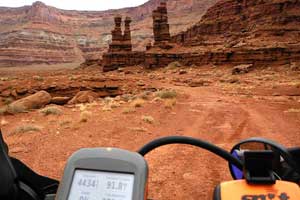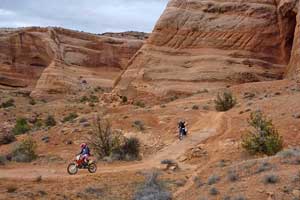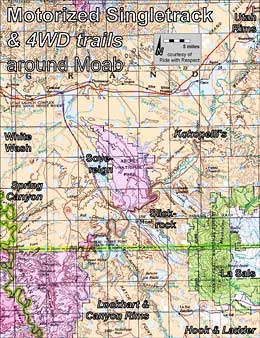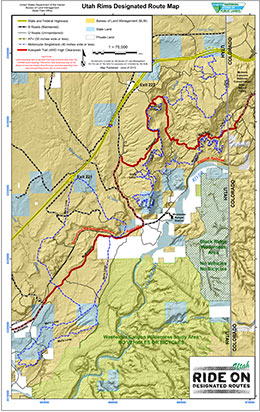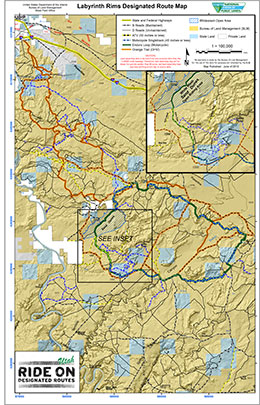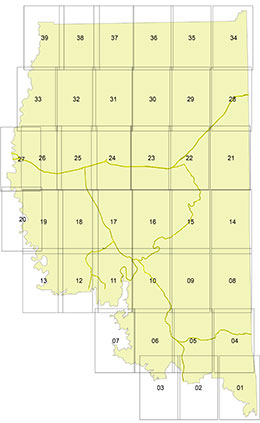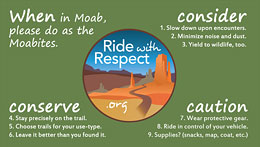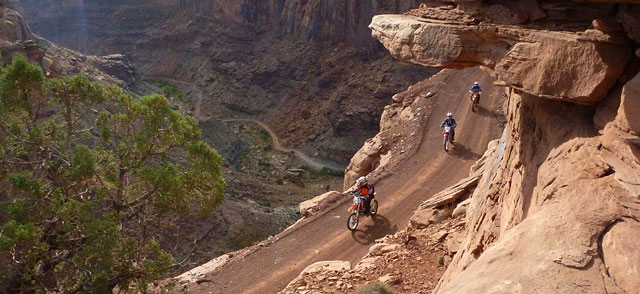
Moab Area Motorcycle Trail Riding
Introduction
The Moab area offers tremendous diversity for motorcycle trail riding. From graded roads to singletrack trails, you can
choose a new adventure for each day of your visit… and your next visit. With that sense of freedom comes a responsibility
to respect yourself, others, and the land itself. So please remember to ride within your ability, stay precisely on the designated roads and
trails, and yield to people or animals. This will help to keep Moab accessible and enjoyable for generations.
Motorcycling takes a lot of rider training, vehicle maintenance, and trip planning. In Moab, a handful of guiding and rental
services can assist you to make the most of your visit. If choosing to go out with your own group, be prepared. Most
trails are very remote, and cellular coverage is spotty. Even in spring and fall, temperatures can reach above 100F and
below 32F. Low humidity calls for bringing extra water, such as 4 quarts/liters per person. Storms cause drainages that
are normally dry to become impassable, and cause clay-based dirt that is normally dusty to become extremely muddy.
Lockhart Basin, a remote 4WD trail, offers views up to Canyon Rims Recreation Area. Photo courtesy of Dave Walker
Kokopelli Trail, which is very popular for bicycling, uses many 4WD trails to reach Colorado. Photo courtesy of RwR
Along with the proper gear, groups should bring travel maps and possibly guide books. Although most of the graded roads
and featured trails have directional signs, conditions are subject to change. In the event of an emergency, maps can
show your options to evacuate. The government-agency maps and most commercial maps indicate which types of travel are
permitted for each route. Be aware that motorcycles are not permitted on many singletrack trails, especially those closer
to town.
On public lands, motorized and even bicycle travel is limited to designated routes. The Bureau of Land Management (BLM)
provides up-to-date designated route maps. Likewise, the U.S. Forest Service (USFS) provides
up-to-date motor vehicle use maps. Commercial
maps include Moab Classic and Moab East/West by Latitude 40, which are available at the Moab Information Center (Main
& Center Streets in Moab). Guide books include ATV Trails Guide and Backroads & 4-Wheel Drive Trails. These books are
available at the Moab Information Center, and can also be purchased in advance online from Canyonlands Natural History Association.
4WD trails are the perfect way for most motorcyclists to explore the canyon country. These primitive roads offer spectacular
scenery, with difficulty that ranges from moderate to extreme. Their width provides room to pass, and provides an alternate
line for riders to choose. Most of the routes used during Jeep Safari are marked, and extend from Moab in every direction.
Originally blazed for uranium mining, these iconic trails made Moab a top 4WD destination, worldwide. For details, see
our page on 4-Wheeling.
Riders seeking a longer-distance, or less-rugged, experience can utilize the network of graded, dirt roads. They are generally
maintained, but of course wash outs and other hazards can occur. If your motorcycle is street-legal, you can follow graded
roads all the way to towns like Green River, Monticello, and even Fruita, CO. Kokopelli’s Trail is dual-sport friendly,
except for the rocky hill above Onion Creek and the non-motorized section below Cisco. Even ‘in the middle of nowhere,’
you could encounter oncoming traffic, so be careful around blind corners.
Note that, to ride the roads in national parks, your motorcycle must be street-legal and a permit is required. (Click here for permit information.) While Canyonlands and Arches are known for routes like White
Rim, Elephant Hill, and Eye Of The Whale, the national parks have a mission of preservation. All kinds of use in these
parks are regulated, so please be on your best behavior. For more information, visit Canyonlands or Arches.
At the most primitive end of the spectrum, motorized singletrack is available for riders seeking the confines of a narrow
trail. These routes typically require a high degree of balance and coordination. Also they lend themselves to lighter-weight
motorcycles with a smoother power band and low gearing. Unless you particularly value singletrack, then stick to the
4WD trails for a greater sense of freedom.
For example, motorized singletracks are shared with non-motorized users, and motorcyclists should yield to them. However
pulling off the singletrack could easily damage plants and biological soil crust (the black and craggy dirt that’s actually
alive). So you’ll need to pass by either leaning over the trail’s edge, or finding a barren surface such as slickrock
to pull over. In the desert, singletrack is a scarce commodity, so please help to keep the “single” in singletrack.
If narrow trails sound like your idea of fun, there are a half-dozen small networks of motorized singletrack to choose
from. Each of them requires a map, but here’s an overview:
-
Hook & Ladder
The Ride:
While this trail system lacks singletrack, it has a fifty-inch ATV trail, and many
4WD trails that weave between the pinion and juniper trees. It lies in an area called the Cameo Cliffs which
is a couple thousand feet higher than Moab, and usually about five degrees cooler. Nearby is the Mi Vida mine
that made Charlie Steen famous. Even the inactive mines are often private and unstable, so view them from a distance.
With cooperation from BLM, an ATV club named SPEAR developed Hook & Ladder for a great day of riding in late
spring or early fall.
-
Slickrock Trail
The Ride:
Also with cooperation from BLM, motorcyclists marked Slickrock Trail in 1969. The
loop scales many hills of barren rock, with views down to the Colorado River and up to the La Sal Mountains.
Since then, Slickrock has become world renowned for bicycling. To avoid crowds, it’s much better to ride Slickrock
early in the week, and early in the morning. Despite heavy traffic, the area is in good shape thanks to the staff
of Sandflats Recreation Area. The small entry fee will get you a detailed map of Slickrock and the surrounding
4WD trails. Although Slickrock might look like Mars, it can feel like Venus. Avoid the afternoon heat, and carry
extra water.
Further Info:
Grand County – Sandflats
-
Sovereign Trail
The Ride:
Similar to Slickrock, Sovereign is very popular among mountain bikers, so be prepared
to share the trail. Sovereign Singletrack connects Archview Resort with lower Klondike Bluffs Road. The middle
of it runs parallel to Saltwash Singletrack, which is recommended for northerly travel. Both singletracks wiggle
through boulder fields and scale ledges. When approaching a switchback, stay on the outside of the turn so you
can cut to the inside at the apex. If it’s too tight, ride the nearby Sovereign ATV Loop or Fallen Peace Officer
Trail. All these routes were developed by a local nonprofit, Ride with Respect, which was blessed with support
from the Utah division of Forestry, Fire, & State Lands.
Further Info:
Ride with Respect updates an extensive map of Sovereign Trail System, which
is available at the MIC and local shops). Beyond Sovereign,
the BLM and national-park trails are reserved for non-motorized use.
Ride with Respect
-
White Wash (north of Dubinsky)
The Ride:
The White Wash Sand Dunes, as well as a peninsula of slickrock east of the dunes,
is the only area around Moab that’s open to cross-country travel. There are a few special requirements, such
as whip flags and portable toilets. For details, see our page on ATV riding. While ‘play’ riders might be content
at White Wash, trail riders could explore north toward Crystal Geyser, and south toward Tenmile Canyon. This
wet canyon was an oasis for early Native Americans, and it’s a modern oasis for wildlife. If you ride Tenmile,
please keep its significance in mind. Also, desert bighorn sheep roam this area. The sheep feel safer when they
are uphill of people, so it’s our responsibility to give them plenty of room. With sign supplies from Utah State
Parks & Recreation, staff of the BLM have spent many days marking this trail system. Nevertheless, it’s in the
way-backcountry, so self-sufficiency is vital.
-
Utah Rims (west of Rabbit Valley)
The Ride:
The mesas above Bitter Creek make up this other BLM area that focuses on motorized
singletrack. The routes may have many rocks and few directional signs, but they provide great views northward
to the Bookcliffs and southward to the Colorado River. Eagles nest beside the river, which is closed to mechanized
travel. Eastward, Utah Rims connects with more trails in the McInnis Canyons National Conservation Area. Westward,
riders can reach a sandy singletrack called Mel’s Loop. Note that the nearby Westwater Wilderness Study Area
(WSA) is closed to mechanized travel. Since most lands are managed for multiple uses, WSAs are some of the only
areas that continuously provide a sense of solitude. The nearby BLM ranger station serves as a put-in for many
rafting trips.
-
La Sal Mountains
The Ride:
Although it’s a small mountain range, the La Sals provide a summertime escape for
people and animals, alike. Above Moab, the national forest includes a small network of rugged roads across Brumley
and Dorry creeks. For motorized singletrack, one must travel to the backside of the La Sals, onto land owned
by Utah’s School & Institutional Trust Lands Administration (SITLA). Although the agency’s primary mandate is
to raise funds for education, fortunately SITLA allows public access. The Trust Lands Singletrack and an ATV
loop called Trail 16 are short, but sweet. For the sake of wildlife, hunting, and safety, please do not ride
the singletrack within three hours of sunrise or sunset. Like Sovereign Trail, Ride with Respect has invested
thousands of hours of work toward these trails. Please tread lightly, and avoid muddy conditions.
Biological Soil Crust
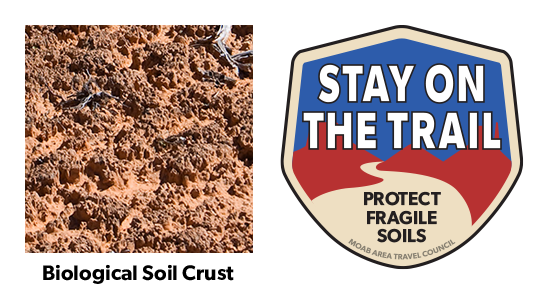
Help to keep all of our trails open. Protect this fragile, but crucial, soil by remaining on designated roads, routes and trails at all times.
Biological soil crust, also known as cryptobiotic soil, is the foundation of desert plant life. This black, knobby crust is made up of many different living organisms and plays a vital role in maintaining the desert ecosystem. However, this sensitive soil is extremely fragile and can take decades to grow. Even a footstep can damage the crust for decades, having lasting impacts on the desert environment. Please stay on the trials. Help to protect this fragile life by remaining on designated roads, routes, and trails at all times. Where hiking trails are not established, hike in sandy washes or on bare rock.
Long-Term Parking in Moab
Need somewhere to to park your vehicle or trailer overnight? Although the city of Moab does not have any public long-term parking areas, these companies provide safe, secure storage.
Preserve & Protect
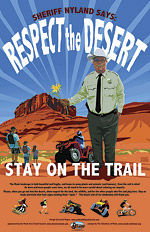
Moab’s roads and trails are famous because they offer a combination of challenge and scenery that cannot be found elsewhere.
Please remember that riding on public lands is a privilege, not a right. Protect this privilege by staying on designated
roads and trails. Cross-country travel damages plant and soil resources, and leaves ugly long-lasting scars. Enjoy your
recreational activity in the Moab area while staying on roads and trails.
In conclusion, a handful of motorized-singletrack areas complement the many 4WD trails that put Moab on the map, so to
speak. Plan ahead, or utilize one of the town’s many outfitters. As the budgets of land managers have dwindled, it’s
now key for motorcyclists to become trail stewards. You can even pitch in through a club like Ride with Respect, or volunteer
directly through a land manager like BLM.
Above all, practice an outdoor ethic. Have a blast, but keep an eye out for your safety, for other visitors, and for the
surrounding landscape. This combination of fun, challenge, camaraderie, and sheer beauty draws many people back to Moab
time and time again.
*NOTE* Utah State Parks & Recreation enforces several important rules regarding vehicle registration, equipment, youth
certification, and safety gear. For an overview see our ATV page. For the latest up-to-date
regulations, it is critical to visit ohv.utah.gov.



